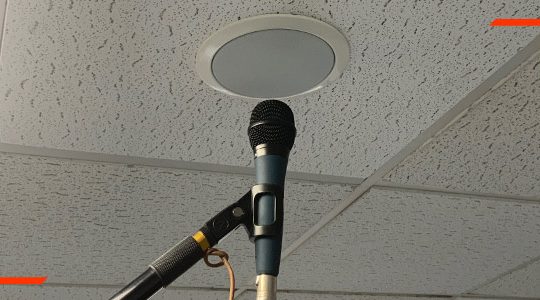Ear on a stick
In our industry, there are often obstacles put in our way that frustrate the life out of you. Architects that don’t want to see anything, but then want the best sound everywhere is one that springs to mind. But this article isn’t about that, it’s about the wonderful world of Health and Safety. We’ve all had our grumbles about Health and Safety, but it’s a necessary evil that we all need to work with to make sure we all go home at the end of the day and, just like this case, it can sometimes yield great little ideas.
A recent project for us resulted in a discussion about safe working methods and prompted us to get our thinking caps on to come up with a solution that worked without putting anybody at risk. The site we’d inherited had a PAVA system with about 70 loudspeaker circuits divided into over 40 zones but was there a drawing available showing what was wired to what? Of course there wasn’t!
The client asked us to map out the site for them, so a decision could be made on how to move forward and get the system up to scratch. The entire site was heavily populated with members of the public and staff, so background noise levels would be an issue if we decided to pop an impedance meter on each cable and go and find each connected loudspeaker one by one. Although this work would’ve been easier during the night, it was still going to be a tedious process so we proposed to record some digital messages simply saying ‘Circuit One’, ‘Circuit Two’ etc.
These messages would be played simultaneously to all circuits and then we could just go round the site, mark the speaker location on a plan and put a note on relating to which circuit they were connected to. The control and amplification system were capable of this doing this,so we put our proposal forward to the powers that be, but it was decided that the disruption this would cause was unacceptable for the customers using the facility.
It was then put forward that we would simply turn down the broadcast so it couldn’t be heard unless you were extremely close to the loudspeakers. This was accepted, but it also opened the can of worms about how we’d get to each loudspeaker. Our engineers were ready to go off with stepladders, ladders, scaffold and cherry picker but the site deemed this too unsafe in areas populated by the public, despite risk assessments and method statements supporting cordoned off work areas. It was during a discussion about the working method that one of us quipped “It’s a shame we can’t just put our ear on a stick and work from the ground!”.

A recent project for us resulted in a discussion about safe working methods and prompted us to get our thinking caps on to come up with a solution that worked without putting anybody at risk.
Mmmmm? Maybe we can….
My mind drifted off to the broadcast world and a safe solution was simpler than you’d think. Let’s get a hypercardioid microphone and a good quality fishpole that will extend to the highest loudspeaker, this would allow us to work from the floor, during normal working hours, and amongst the public with little cordoning off required – the perfect solution, simply extend the mic up to each loudspeaker and listen to what comes out of it. One small stumbling block was how would we hear what the microphone was picking up and still keep it completely portable? Fortunately, we’d used a small monitor pre-amp in the past that could work from a power supply or a PP3 9v battery, with a suitable microphone input, level control and had a headphone output too.
All the parts were purchased, put together and our ‘Ear on a stick’ came to life. The survey was completed in a quarter of the time, without any fuss or further scrutiny and ultimately resulted in a happy customer and relieved engineers who didn’t have to climb up and down access equipment again and again!
For those of you interested in making your own there’s a lot of kit available, you’ve probably even got some of it lying around, but here’s what we used, and it worked very well for us:
Equipment List
AudioTechnica MB3K Hypercardioid Microphone
Rode BOOMPOLE 3.2m Fishpole
ART MyMONITORII Pre-Amplifier Monitor
Sony MDRZX110B.AE On-Ear Headphones
Duracell PP3
NC3FXX Female XLR Plug
NC3MXX Male XLR Plug
4m good quality microphone cable.
All the parts were purchased, put together and our ‘Ear on a stick’ came to life. The survey was completed in a quarter of the time, without any fuss or further scrutiny and ultimately resulted in a happy customer and relieved engineers who didn’t have to climb up and down access equipment again and again!
Finally, if you’re wondering which system was capable of playing 70 digital messages simultaneously, it was a TOA VX-3000 series voice alarm system.
Paul Dougherty MInstSCE, is the Managing Director for Blaydon Communications Ltd and a member of the ISCVE.



